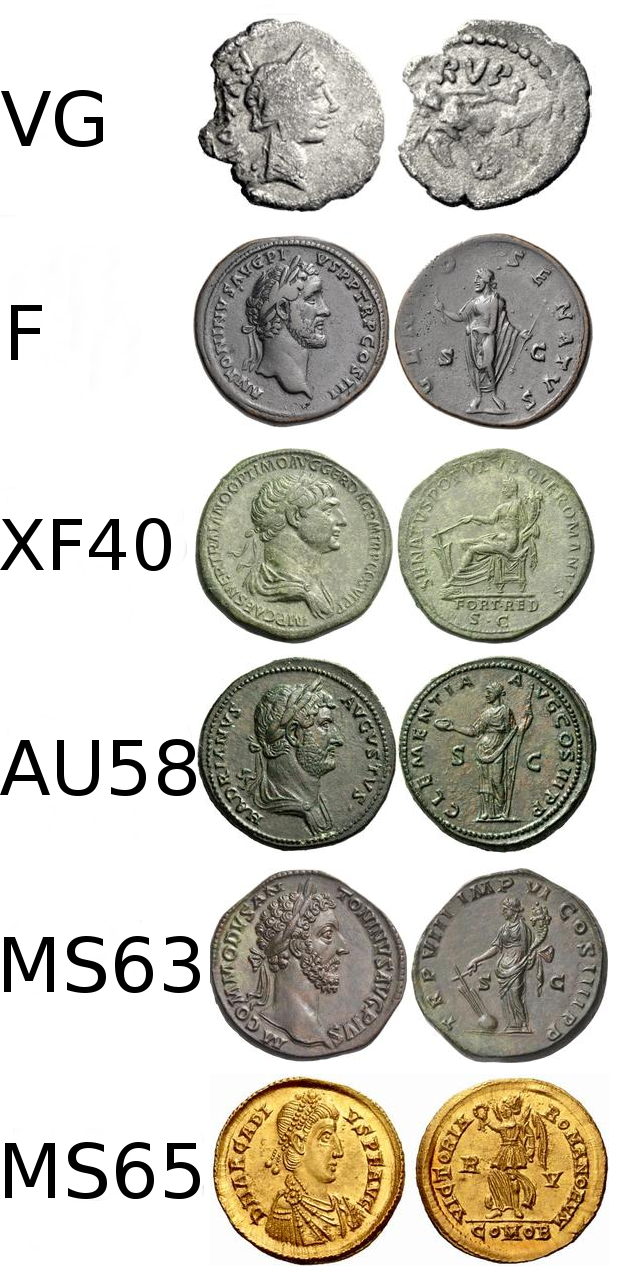Buying ancient Roman coins can be done through reputable dealers or auction houses. Dealers are usually very knowledgeable and can verify the authenticity of coins. You can also buy certified to be authentic coins on various sites online (see further below). VISUAL CATALOGUE: Study of the late roman bronze coins covering 247 types of reverses of the period A.D. 313 - 498 (RIC VII - X). Collectible coins of Imperial Rome tell us about the emperors and the economic conditions of their times. This product category includes Roman imperial coins and accessories for collecting them. How do these coins fit into history? According to ancient legend, the city of Rome was founded in 753 BC. Coins of ancient Rome generally fall into two categories—those struck during the Roman Republic, which lasted from 509 until 27 BCE, and coins minted during the Roman Empire, which ran its course in the West at the end of the 5th century.
The beginnings

Although Roman coinage soon diverged from Greek conventions, its origins were similar. Rome, founded in the 8th century bc, had no true coinage until the 3rd. Roman historians later attributed coinage unhesitatingly to the much earlier regal period: some derived nummus (“coin”) from Numa Pompilius, by tradition Rome’s second king, and Servius Tullius was credited with silver coinage, as well as with bronze stamped with the device of cattle. Roman historical tradition, however, seriously confused the elements of the true picture. Rough, unworked lumps of bronze (aes rude) were certainly used as a metal currency from the 6th century, if not much earlier, perhaps in rare conjunction with very small quantities of unworked gold and silver, themselves also passing by weight. Simultaneously, standards of value appear to have been expressed in terms of cattle and sheep, as is clear not only from the derivation of pecunia (“money”) from pecus (“cattle,” or “sheep”) but also from the early assessment of fines in oxen and sheep. From this it was falsely concluded that bronze coins marked with the device of cattle existed from the 6th century. In fact, the expression of values in terms of cattle may have lasted, officially, into the 5th century, for it was not until the decemvirs (a legislative commission) codified the law and drew up the Twelve Tables (451–449 bc Blackjack discord server. ) that fines were fixed in bronze. This bronze still consisted of unworked lumps or, at most, rough bars of irregular weight.

Roman Coin Identification Pictures
During the 4th century bc, Roman contact with the Greek cities of southern Italy slowly increased; these included such prolificmint cities as Nola, Hyria, and Naples. The coinages of these cities consisted of silver didrachms, of which Rome presumably made use in any necessary dealings with them. A hint is given, however, of widening Roman monetary interests by two issues of bronze token coinage. These, though certainly not produced at Rome, may perhaps be regarded as the earliest coins in the name of the Romans, struck at Naples about 325–285 within the terms of their alliance and intended for use in Campania, as distinct from Rome and Latium. It is unlikely, indeed, that a mint in the proper sense existed at Rome before 289, the year to which Pomponius assigned the establishment of tresviri (a board of three officials) who should be aeris flatores (“bronze melters”); and this mint (in the temple of Juno Moneta) did not yet produce true coins but aes signatum, bronze bars (of about six pounds) lacking a mark of value but bearing on each side a clearly recognizable type (including cattle) and perhaps equivalent in value to a Greek silver didrachm.

Ancient Roman Coins Wiki

Although Roman coinage soon diverged from Greek conventions, its origins were similar. Rome, founded in the 8th century bc, had no true coinage until the 3rd. Roman historians later attributed coinage unhesitatingly to the much earlier regal period: some derived nummus (“coin”) from Numa Pompilius, by tradition Rome’s second king, and Servius Tullius was credited with silver coinage, as well as with bronze stamped with the device of cattle. Roman historical tradition, however, seriously confused the elements of the true picture. Rough, unworked lumps of bronze (aes rude) were certainly used as a metal currency from the 6th century, if not much earlier, perhaps in rare conjunction with very small quantities of unworked gold and silver, themselves also passing by weight. Simultaneously, standards of value appear to have been expressed in terms of cattle and sheep, as is clear not only from the derivation of pecunia (“money”) from pecus (“cattle,” or “sheep”) but also from the early assessment of fines in oxen and sheep. From this it was falsely concluded that bronze coins marked with the device of cattle existed from the 6th century. In fact, the expression of values in terms of cattle may have lasted, officially, into the 5th century, for it was not until the decemvirs (a legislative commission) codified the law and drew up the Twelve Tables (451–449 bc Blackjack discord server. ) that fines were fixed in bronze. This bronze still consisted of unworked lumps or, at most, rough bars of irregular weight.
Roman Coin Identification Pictures
During the 4th century bc, Roman contact with the Greek cities of southern Italy slowly increased; these included such prolificmint cities as Nola, Hyria, and Naples. The coinages of these cities consisted of silver didrachms, of which Rome presumably made use in any necessary dealings with them. A hint is given, however, of widening Roman monetary interests by two issues of bronze token coinage. These, though certainly not produced at Rome, may perhaps be regarded as the earliest coins in the name of the Romans, struck at Naples about 325–285 within the terms of their alliance and intended for use in Campania, as distinct from Rome and Latium. It is unlikely, indeed, that a mint in the proper sense existed at Rome before 289, the year to which Pomponius assigned the establishment of tresviri (a board of three officials) who should be aeris flatores (“bronze melters”); and this mint (in the temple of Juno Moneta) did not yet produce true coins but aes signatum, bronze bars (of about six pounds) lacking a mark of value but bearing on each side a clearly recognizable type (including cattle) and perhaps equivalent in value to a Greek silver didrachm.
Ancient Roman Coins Wiki
These aes signatum bars were halfway between aes rude and true coinage. In 269 true coinage appeared. It consisted of aes grave, large circular cast coins of bronze all bearing marks of value, from the as (weighing one pound) down to its 12th, the uncia; the obverses showed the head of a deity, the reverses a ship’s prow. These were paralleled at mints elsewhere by similar cast coins; their types showed not, as at Rome, Latin deities but rather Greek (in the south) or Umbrian and Oscan. At the same time, there appeared struck silver didrachms, on the standard of the Greek silver coins of Campania, bearing Greek types but marked ROMANO or ROMA. Accompanied by small struck bronze token coins, these were issued from Campanian mints, and they probably continued to the Second Punic War, terminating in a new issue of silver coins of Roman style and types (marked ROMA), including Jupiter in a quadriga (four-horse chariot) from which their name, quadrigati, derived; they were imitated in electrum by the Carthaginians in Capua. The quadrigati were of the weight of the lighter Romano-Campanian didrachms and reflected the rising cost of silver at a time of stress; concurrently the cast bronze coinage of Rome dropped steadily in weight from an as of one pound to one of three ounces or less. Financial stress is similarly to be seen in the exceptional issue of gold units and halves. Toward the end of the Second Punic War the quadrigati were replaced by silver coins of half their weight, with a Victory on the reverse, and hence called victoriates. By about 190 a mainly silver coinage, Latin-inscribed, was in production at Rome and other authorized mints, accompanied by bronze coinage so greatly reduced in standard (and thus size) that it could at last be struck instead of being cast.
